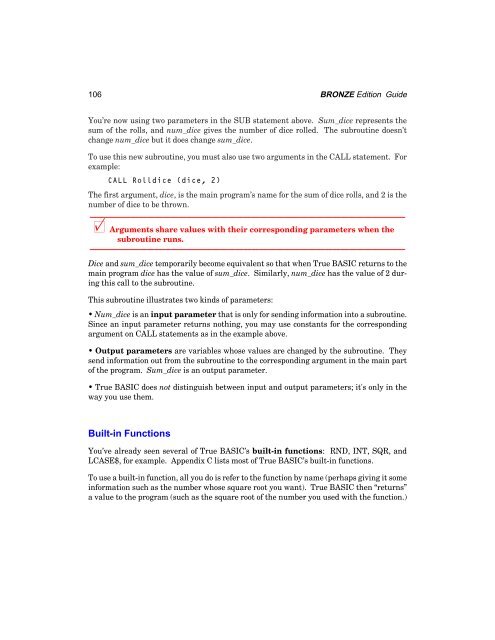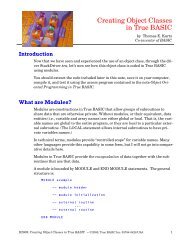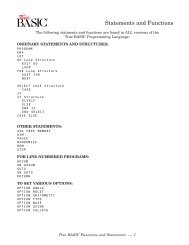Bronze Edition Guide - True BASIC
Bronze Edition Guide - True BASIC
Bronze Edition Guide - True BASIC
You also want an ePaper? Increase the reach of your titles
YUMPU automatically turns print PDFs into web optimized ePapers that Google loves.
106 BRONZE <strong>Edition</strong> <strong>Guide</strong><br />
You’re now using two parameters in the SUB statement above. Sum_dice represents the<br />
sum of the rolls, and num_dice gives the number of dice rolled. The subroutine doesn’t<br />
change num_dice but it does change sum_dice.<br />
To use this new subroutine, you must also use two arguments in the CALL statement. For<br />
example:<br />
CALL Rolldice (dice, 2)<br />
The first argument, dice, is the main program’s name for the sum of dice rolls, and 2 is the<br />
number of dice to be thrown.<br />
———————————————————————————————————————<br />
x Arguments share values with their corresponding parameters when the<br />
subroutine runs.<br />
———————————————————————————————————————<br />
Dice and sum_dice temporarily become equivalent so that when <strong>True</strong> <strong>BASIC</strong> returns to the<br />
main program dice has the value of sum_dice. Similarly, num_dice has the value of 2 during<br />
this call to the subroutine.<br />
This subroutine illustrates two kinds of parameters:<br />
• Num_dice is an input parameter that is only for sending information into a subroutine.<br />
Since an input parameter returns nothing, you may use constants for the corresponding<br />
argument on CALL statements as in the example above.<br />
• Output parameters are variables whose values are changed by the subroutine. They<br />
send information out from the subroutine to the corresponding argument in the main part<br />
of the program. Sum_dice is an output parameter.<br />
• <strong>True</strong> <strong>BASIC</strong> does not distinguish between input and output parameters; it's only in the<br />
way you use them.<br />
Built-in Functions<br />
You’ve already seen several of <strong>True</strong> <strong>BASIC</strong>’s built-in functions: RND, INT, SQR, and<br />
LCASE$, for example. Appendix C lists most of <strong>True</strong> <strong>BASIC</strong>’s built-in functions.<br />
To use a built-in function, all you do is refer to the function by name (perhaps giving it some<br />
information such as the number whose square root you want). <strong>True</strong> <strong>BASIC</strong> then “returns”<br />
a value to the program (such as the square root of the number you used with the function.)









